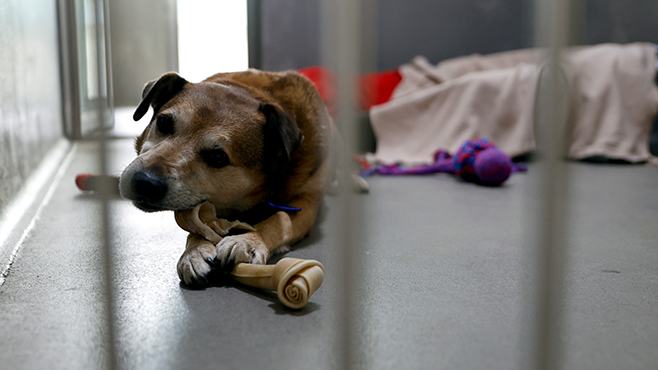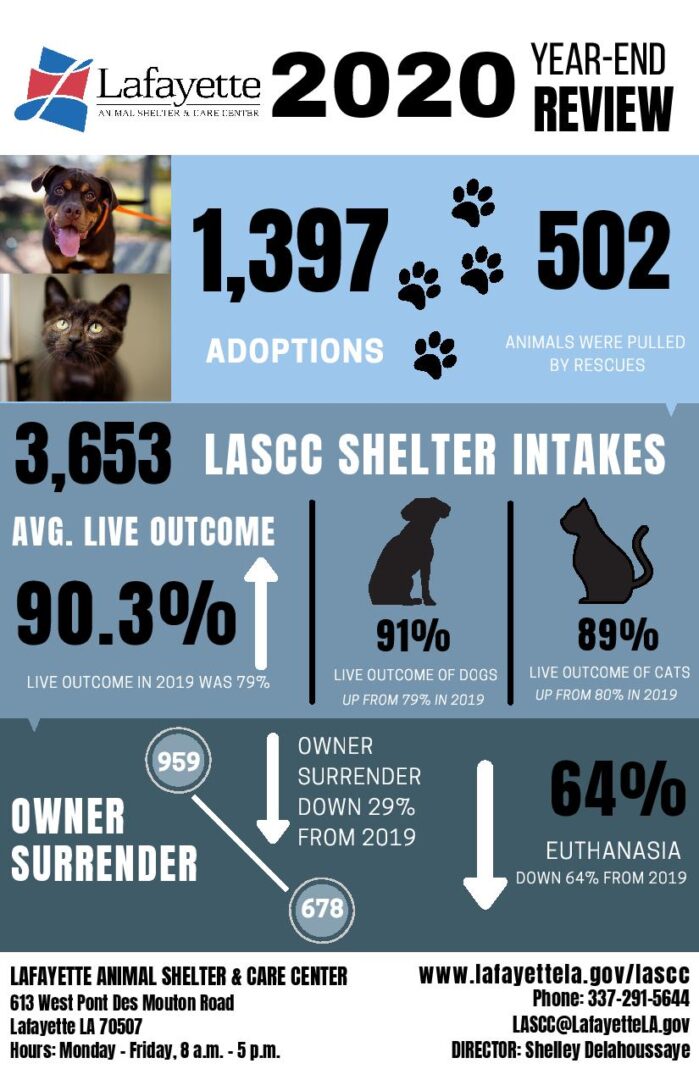
The Lafayette Animal Shelter & Care Center (LASCC) has reached no-kill status, meaning the shelter has saved the lives of 90 percent or more of the animals at the shelter. “Strategic, innovative methods and procedures were put into place at the shelter in order to achieve this coveted goal,” Director Shelley Delahoussaye said. No-kill includes adopting out healthy animals and only euthanizing terminally ill animals and aggressive animals that can’t be adopted.
Lafayette Mayor-President Josh Guillory said, “This is not only an accomplishment for the shelter, but also for the entire Lafayette community. Our staff and volunteers at the shelter put in the hard work, but it’s our citizens who visit daily to adopt, volunteer, and foster who are the real MVPs.”
It was former Lafayette Mayor-President Joel Robideaux’s goal, when he took office in 2016, to achieve no-kill status by 2020 by decreasing the number of euthanized animals and increasing adoptions. “I’m so proud of the staff who worked to achieve this goal. Lafayette is an animal-friendly community, and now our shelter reflects that,” Robideaux said. In 2015, the year before Robideaux took office, only 28.01 percent of dogs and cats left the shelter alive — 47.49 percent of dogs and 9.62 percent of cats.
𝗛𝗢𝗪 𝗧𝗛𝗘 𝗦𝗛𝗘𝗟𝗧𝗘𝗥 𝗥𝗘𝗔𝗖𝗛𝗘𝗗 𝗧𝗛𝗘 𝗡𝗢-𝗞𝗜𝗟𝗟 𝗕𝗘𝗡𝗖𝗛𝗠𝗔𝗥𝗞
𝙏𝙧𝙖𝙥-𝙉𝙚𝙪𝙩𝙚𝙧-𝙍𝙚𝙩𝙪𝙧𝙣 𝙥𝙧𝙤𝙜𝙧𝙖𝙢 (𝙏𝙉𝙍)
In 2017, the Lafayette Animal Code of Ordinances was amended to include a trap, neuter, return program which allows humanely trapping feral and stray cats to be spayed or neutered then returned to their habitat. The old method of trapping and euthanizing was inhumane and only temporarily decreased population levels, as more cats would move into the area and procreate.
𝙍𝙚𝙙𝙪𝙘𝙚𝙙 𝘼𝙙𝙤𝙥𝙩𝙞𝙤𝙣 𝙁𝙚𝙚𝙨 𝙛𝙤𝙧 𝘿𝙤𝙜 𝙖𝙣𝙙 𝘾𝙖𝙩𝙨
The shelter decreased adoption fees from $100 to $35 for dogs and $80 to $25 for cats. Also, fees were waived for military veterans and senior citizens over the age of 65.
𝙈𝙖𝙣𝙖𝙜𝙞𝙣𝙜 𝙄𝙣𝙩𝙖𝙠𝙚
LASCC used to accept all animals, whether strays or owner surrenders. Now, people must schedule an appointment. “This gives us the opportunity to counsel the person to hopefully prevent pet surrenders. As for stray animals, they’re usually found within one to three miles of their home. By making an appointment, we ask the citizen to share pictures on social media, post flyers, and ask neighbors if they recognize the pet,” Delahoussaye explained.
𝙄𝙣𝙘𝙧𝙚𝙖𝙨𝙞𝙣𝙜 𝙁𝙤𝙨𝙩𝙚𝙧 𝘾𝙖𝙧𝙚
Sometimes foster families adopt pets they are temporarily caring for, but most of the time the foster family finds a forever home for them. “During the COVID-19 lockdown, we put more than 60 dogs in foster homes, and 100 percent of them found permanent homes,” Delahoussaye said.
𝙈𝙖𝙞𝙣𝙩𝙖𝙞𝙣𝙞𝙣𝙜 𝙖𝙣𝙙 𝘾𝙧𝙚𝙖𝙩𝙞𝙣𝙜 𝙉𝙚𝙬 𝙍𝙚𝙡𝙖𝙩𝙞𝙤𝙣𝙨𝙝𝙞𝙥𝙨 𝙬𝙞𝙩𝙝 𝙍𝙚𝙨𝙘𝙪𝙚 𝙋𝙖𝙧𝙩𝙣𝙚𝙧𝙨 𝘼𝙧𝙤𝙪𝙣𝙙 𝙩𝙝𝙚 𝘾𝙤𝙪𝙣𝙩𝙧𝙮
LASCC created relationships with animal rescue organizations around the country where pet overpopulation is not a challenge. LASCC sends pets to states like Florida, Colorado, New Jersey and others that tend to have responsible pet owners who spay or neuter their pets, resulting in fewer pets to adopt.
Mayor-President Guillory’s Chief of Staff Robert Benoit, along with Delahoussaye, have overseen no-kill efforts. Benoit said, “We hit a milestone in March 2019, our first month ever in history, to achieve a 91 percent no-kill rate. The following month, we were flooded by owners surrendering their pets. The community thought because we were trying our best not to euthanize, it would be a safe place to surrender their unwanted pets.”
In the months following, staff worked once again to reach no-kill status to pull off the 2020 goal. “Our staff and volunteers began using managed intake strategies, such as counseling owner surrenders to figure out why they wanted to surrender their animals and how we can help keep them in their home,” he said.
The COVID-19 pandemic played a huge roll in changing the way shelters around the country operate. Remote adoptions, more people available to foster due to the stay-at-home-order, and appointments for intake were huge factors in permanently moving animals out of kennels and into forever homes. “It’s our number one goal to save every animal that does not have a severe behavior or medical issue. We have team meetings to discuss animals that are in question, and together we make decisions to achieve the best possible live outcome for those animals,” Delahoussaye said.
Reaching the no-kill goal comes just in time for the completion of the new Lafayette Animal Shelter and Care Center set to open in April.


